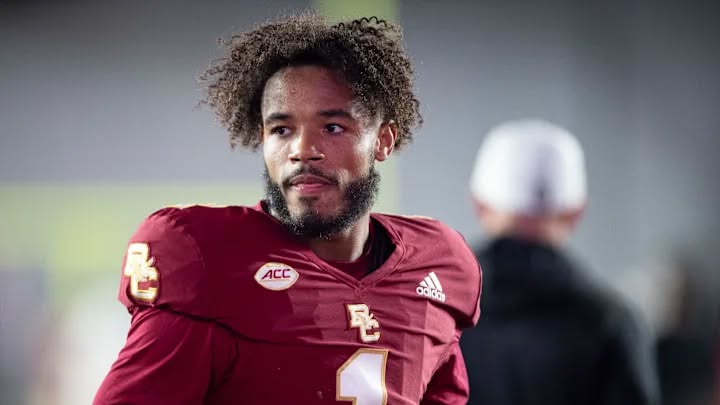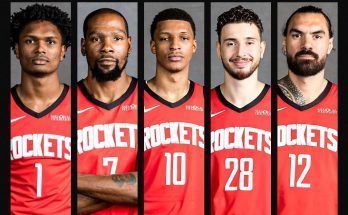Florida State QB Thomas Castellanos Fires Shots at Alabama, Crimson Tide DL Tim Keenan III Delivers Fiery Response.
You can practically feel the humidity of July camp season thickening around the sport whenever a quarterback lets a little swagger slip, and that’s exactly what happened when Florida State’s Thomas Castellanos offered a few pointed words about Alabama that rippled across the college football ecosystem in hours. Castellanos didn’t drop anything obscene, and he didn’t threaten bulletin-board immortality in the classic Joe Namath sense, but his tone was unmistakable: Florida State isn’t backing down from the SEC bully, and the Seminoles believe their speed, tempo, and quarterback mobility can stress even a blue-blood defensive line like Alabama’s. In an era where every post-practice scrum can become a national talking point within minutes, that was all it took. Crimson Tide defensive lineman Tim Keenan III heard it, didn’t love it, and decided to answer in kind.
Castellanos has always had a live-wire competitive streak that makes him easy for teammates to follow and just as easy for opponents to circle in red. His transfer into Florida State injected a backyard-playmaker vibe into an offense that had been searching for consistent improvisational explosives when structure broke down. He’s a slippery runner, comfortable flipping his hips to deliver throws while rolling, and he likes to push tempo after chunk gains. So when he was asked—half seriously, half baitingly—how he thought FSU would match up with Alabama’s front if the two teams saw each other in the postseason picture, he grinned and leaned into the question. The summary: if Alabama wants to play power-on-power, fine, but they’ll have to chase him for sixty minutes, and FSU won’t be intimidated by “a name on the jersey.” That last phrase was the spark.
Tim Keenan III, a space-eating interior presence who carved out a reputation for technique, leverage, and film obsession, is not the loudest voice in Tuscaloosa’s locker room. But when he does speak, teammates notice. Word filtered back to him that Castellanos suggested Alabama’s defensive line might struggle in space, and Keenan responded during media availability with something far more pointed than the politely robotic “we respect every opponent” standard-issue line. Without raising his voice, he said Alabama relishes when quarterbacks try to run, because that gives his unit chances to hit, strip, and change games. He added that the Tide “don’t do names on jerseys—we do habits, we do gaps, we do finishing plays,” which is the kind of comment that plays double-duty: outwardly respectful of process, inwardly dismissive of FSU’s implied speed advantage.
The exchange lit up social channels because it hit several college football dopamine buttons at once: SEC vs. ACC pride, blue-chip defensive trenches vs. dual-threat quarterback magic, and the ever-expanding playoff field that makes hypothetical cross-conference showdowns feel more real months in advance. Florida State fans clipped Castellanos’ comments and blasted them across message boards as proof of the program’s renewed swagger. Alabama fans countered with highlight montages of Tide linemen swallowing mobile quarterbacks in past postseason games. Neutral fans just grabbed popcorn and started scheduling imaginary December brackets.
Trash talk is part performance art, part psychological probe, and part branding exercise in 2025. Players understand that NIL era exposure lives in the same feeds where recruiting battles simmer and fan allegiances are monetized. Castellanos’ willingness to jab Alabama isn’t only bravado; it’s savvy attention economics. Every repost extends his personal brand, helps FSU recruiting staffers pitch “we aren’t scared of anybody,” and keeps the Seminoles visible when summer news cycles otherwise drift toward media day platitudes. Keenan’s clap-back works the other side of the ledger: Alabama’s defensive identity has always thrived on external doubt, real or manufactured. A public reminder that the Tide love being challenged gives position coaches fresh motivational clips for the next film session.
Strip away the viral clips and the matchup question underneath is fascinating football. Castellanos stresses defenses horizontally and vertically. Florida State likes to layer quick-game concepts with motion and option looks that can freeze linebackers or widen defensive fronts just enough to create creases. When he breaks contain, he’s not merely scrambling to survive; he’s hunting for explosives—those late crossers that punish DBs who trigger downhill, or backside wheel routes that appear after three seconds of chaos. Alabama, by contrast, is built from the inside out. With Keenan anchoring the A-gaps, the Tide typically trust their interior to muddy run lanes without dedicating extra bodies, freeing linebackers to scrape and fill. Against mobile quarterbacks, Alabama historically mixes simulated pressures—showing heavy rush, then dropping linemen or edge bodies into short zones—to bait hurried throws. That chess match could define a postseason collision.
Another layer: conditioning and tempo. Castellanos hinted that Alabama’s big bodies might wear down if forced to defend 80-plus snaps of hurry-up offense. It’s a classic talking point lobbed at every power-front team, but there’s nuance. Rotational depth matters more than ever when facing a mobile quarterback who extends drives on third-and-medium. If FSU strings tempo after explosive plays, Alabama must substitute cleanly or risk gashed fronts. Keenan, who prides himself on technique efficiency—winning early hand placement, playing with a low pad level so he’s not expending unnecessary energy—argues that good fundamentals travel to tempo games. The moment becomes a referendum on whether Florida State can stack rhythm before Alabama disrupts it with negative plays.
Psychology inside each locker room also shifts when one side talks publicly. Teammates hear what’s said and calibrate urgency. Florida State’s offensive line meetings get a subtle edge: if their quarterback put his chin out, they better protect it. Running backs internalize blitz pickup as personal. Receivers adopt scramble-drill discipline because loose trash talk without execution becomes meme fuel. On the Alabama side, defensive linemen log the comment in the mental file labeled “respect.” It’s not hatred—it’s something better for performance: targeted focus. Coaches won’t need long speeches; they’ll just roll the clip before a nasty inside run period and say, “Earn the right to rush.”
Historical precedent shows trash talk rarely decides games by itself, but it can influence preparation quality. Think back to when mobile quarterbacks from outside the SEC were told they’d “see speed they’ve never seen before” and then responded by repping protection checks obsessively for three weeks. Or when an interior defender swore no one would run the ball and his team proceeded to practice goal-line fits until backs saw four jerseys through every gap. The talk draws the outline; the work colors it in. Castellanos vs. Keenan slots neatly into that lineage: two competitors, two programs with trophy cases and expectation burdens, one offseason comment cycle feeding both.
Recruiting observers are already cataloging the exchange for future living-room stories. A four-star guard in Georgia hears that FSU’s quarterback is calling out Alabama’s front and wonders whether he wants in on that attitude. Meanwhile, an Alabama defensive coach can show the Keenan quote to a nose tackle prospect and say, “We don’t chase the attention, but we answer when it comes.” In an NIL-driven landscape where brand, culture, and perceived fearlessness matter almost as much as scheme fit, even a light dustup becomes sales material.
There’s also the media economy to consider. College football coverage in the expanded playoff era thrives on connective speculation: Who matches up with whom in December? Which styles clash? Which quarterbacks talk and then back it up? By firing early, Castellanos guaranteed that every bracket projection, every computer model thread, and every midseason “if the season ended today” article will include a sidebar reminding readers of the summer spark between him and Tim Keenan III. That’s sustained oxygen. Florida State’s comms staff won’t say it out loud, but staying in national rotation matters, especially when recruiting battles stretch coast to coast.
Of course, talk has an expiration date. At some point pads pop, and the data replaces the discourse. If the two programs meet—whether in a marquee nonconference, an early playoff round, or a national semifinal—the first series will carry extra narrative weight. A designed quarterback keep stuffed for a two-yard loss? Alabama Twitter will resurrect Keenan’s line and flood timelines. A broken play scramble that turns into a 38-yard chunk? Seminole fans will paste Castellanos’ grin in looping GIF form. These emotional swings matter because momentum in college environments often spills from stands to sidelines to scheme calls.
Coaches, predictably, will downplay everything when microphones appear. Expect the “we respect their program,” “we’re focused on our fundamentals,” and “social media isn’t football” boilerplate. But inside the meeting rooms, the staffers who cut scouting tape will not ignore tendencies that align with the talk. If Castellanos really believes he can outrun Alabama’s tackles to the edge, the Seminoles might script early perimeter reads to test contain discipline. If Keenan and the Tide think mobile bravado equals loose ball security, expect targeted rake attempts on second efforts and delayed spy pressures that try to bait late cuts back across the grain.
For fans, and for the broader storytelling that keeps college football alive year-round, this is fun. It’s the oxygen between spring practice and kickoff. It’s the reminder that the sport is still fueled by personality, pride, and the regional chip-on-shoulder energy that made Saturdays sacred long before NIL collectives or twelve-team playoff brackets. Thomas Castellanos didn’t torch Alabama with profanity; he simply refused to genuflect. Tim Keenan III didn’t insult Florida State’s legitimacy; he reminded everyone that Alabama’s identity is earned in film rooms and trenches, not in name recognition alone. Both statements can be true. Together, they set the stage for a matchup that—if we’re lucky—the season will eventually deliver.
So file this moment away. Clip the quotes, save the video snippets, bookmark the takes. When the weather turns cool and the selection committee starts stacking résumés, we may yet arrive at a Saturday (or more likely a late-December primetime) when Castellanos jogs into a huddle across from Keenan, the play clock winds, and millions of viewers remember a summer when words flew first. That’s college football at its best: talk that dares the game to settle the argument, and players on both sides eager to let the pads do exactly that.



